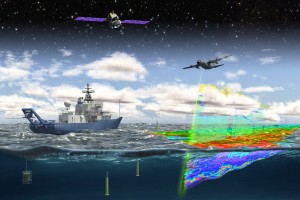
From sea level to satellites, NASA’s NAAMES mission is studying key processes controlling ocean-system function, their influences on atmospheric aerosols, and clouds and their climate-related implications. (Credit: NASA/Tim Marvel)
The North Atlantic Aerosols and Marine Ecosystems Study (NAAMES), a five-year NASA-funded study, is the first NASA Earth Venture-Suborbital mission focused on studying the coupled ocean ecosystem and atmosphere using ships and aircraft simultaneously.
NASA’s ocean-color satellite record finds that plankton ecosystems, for example, are highly responsive to climate variability, with changes in ocean plankton production impacting food (e.g., fish), uptake of atmospheric carbon dioxide by the ocean and ocean emission of climate-regulating aerosols.
Satellite data can be used to calculate the total photosynthesis that goes on in the ocean every year, said Mike Behrenfeld, NAAMES principal investigator. It's essentially equivalent to the total photosynthesis that's happening on land.
NAAMES began in January 2015 and includes four separate ship-aircraft deployments that target specific phases in the annual cycle of the North Atlantic, home to the world's largest plankton bloom, which stretches from North America across the Atlantic to Europe. NASA's C-130 aircraft and the Woods Hole Oceanographic Institution's R/V Atlantis ship are integrated with about a dozen types of scientific instruments that collect important ocean and atmospheric data for research and modeling.

